Modify your Mega Drive/Genesis 32X PAL/NTSC
30.11.2013
Page: 2
Modification
Warning: if you don’t know one end of a soldering iron from another, just keep walking ! ![]()
Disclaimer : you are doing this modification at your own risk and peril; I will in no event be able to be held responsible for any deterioration to your console. This modification does indeed work very well, so if your console is damaged, you will only be able to blame yourself, as the error must have been on your part...
1. Chip 315-xxxx, a few electronics concepts
If you have already switched your Mega Drive 1 and/or 2, you will surely have noticed that the modifications are often centred on a SEGA chip from the 315-xxxx series. This is also the case for the 32X, for which it is the 17th pin of the 315-5788 chip that we need to concentrate on.
Indeed, it is this chip which will determine the console’s frequency (50HZ or 60HZ), depending on what it receives into this pin.
Depending on the potential (tension, voltage) to which the 17th pin is connected, the configuration will change as below:
| 17th pin : frequency | |
| Linked to +5V (logical "1") | -> 60Hz (NTSC) |
| Linked to 0V (logical "0") | -> 50Hz (PAL) |
On a European 32X, by default, we have the 17th pin linked at 0V via a small resistor, and it will be at +5V on a Japanese or American 32X.
The modification will consist of isolating this pin from its actual potential, which imposes the console’s configuration, and sending a wire from this pin towards a switch on which the potentials 0V and +5V will also be sent (which goes without saying).
Note: like most of the chips from the 315-xxxx series, the 315-5788 also has inputs with pull-ups (electronic term); the pull-up, as its name indicates, automatically places the inputs to the higher state (with +5V potential) on which no potential (0V or +5V) is applied.
Consequently, working from this observation, it would not be necessary to send the potential +5V to the switch, which will save time and space.
Despite this, I later decided to send the +5V to the switch anyway as I wanted to do things right, but you don’t have to do the same if you think that two wires is going to be bad enough already… ![]()
2. Positioning
Firstly open your 32X (4 screws), take away the shield (10 screws) so that the electronic circuit around the cartridge port is visible. No need to take anything else to pieces…
The 315-5788 is very easy to find, it is on the right hand side of the cartridge port (when you are facing the console), as can be seen in the photo below:
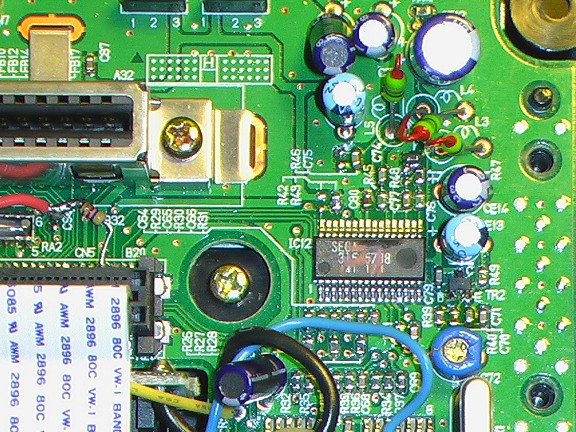
The 17th pin can be found opposite the first pin (shown by the little number 1 in white and the patch) on the chip.
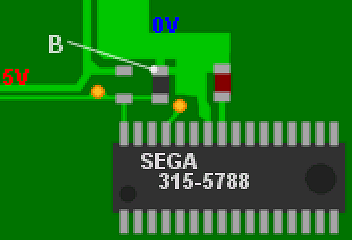 |
On the simplified diagram to the left, you can see a small pathway from pin 17 which splits in 2, and goes towards the left where it joins another part of the card, and towards the right where it joins the ground (0V) through a small black component noted as R43 (resistor). On an NTSC 32X, there is no R43; it is replaced by R42 to the left, joining up pin 17 to +5V. |
3. Modification
The modification that follows is revised and simplified, dating from 2006. If you want to consult the older, more detailed (but also more complicated) version from 2004, please click HERE (French only).
Indeed, in quickly looking over this modification again at the beginning of 2006, I tested the setup of a much simpler version, reducing the modification to 2 wires to solder, and with no craft knife needed!
This is based on the presence of the little resistor R43 (PAL) or R42 (NTSC), which we will use as a pull-down or pull-up respectively, in order to free ourselves purely and simply from the ‘physical’ modification on the motherboard!
In the case of a PAL 32X, R43 creates a pull-down (0V), imposing a PAL configuration, and the space where R42 would be is free. You then just need to solder 2 wires on the space for R42, which you send to a switch, which when it is ‘closed’, will switch pin 17 to +5V (NTSC), and when it is open, will leave it leading to R43, which will switch pin 17 to 0V (PAL)!
...And vice versa for an NTSC 32X!
Here are the wiring schematics depending on your 32X :
| PAL 32X (Europe, Australia) | NTSC 32X (Japan, USA) | ||||||
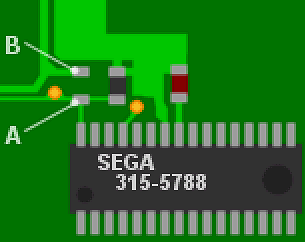 |
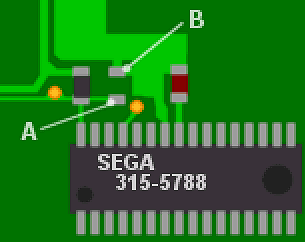 |
||||||
| PAL | NTSC | NTSC | PAL | ||||
|
switch
|
switch
|
||||||
And there you have it!
You have just switched your Mega Drive 32X!
Now it will play anything for you!!! :-p
4. Finalising
You thought that the most difficult part was over? Well no! Here is another conundrum: fixing the switch onto the 32X!
If you want something neat and tidy, you may decide to cut off part of the shield so that you can position your switch without risking an electric shortcut…
The result works fine and looks fine if you do it correctly, as you can see >> |
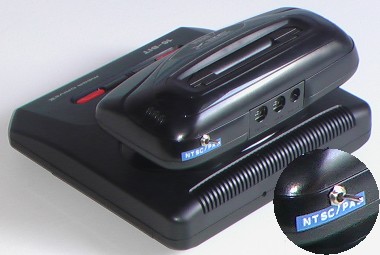 |
Have fun !
Page: 2

